The violet lifts the leaves up: why and what to do?
Among indoor ornamental plants violet occupies a dominant place, despite some difficulties in growing and caring for it. The tenderness of the plant, its appearance depends on the condition of the petals collected in the rosettes. And the leaves only frame the beauty of flowers, settling around. The velvety of the leaf plate, its bright greenery is inseparable from the beauty of the inflorescences. The flower discovered in Africa is called both the Saintpaulia by the name of the discoverer, and the Usambara violet in the area where it was first discovered.
After the discovery of the violet, breeders have perfected the plant so that growers can choose varieties with miniature petals and large ones. And the color scale of the plant is so diverse that one is surprised at the fantasy of man and nature. The variety of shades affected not only the petals of the flower, but also the leaves. The decorativeness of room culture largely depends on their condition.
Content:
- The best varieties of violets, their features
- Why does the violet lift the leaves up?
- How do I fix the problem?
- How to properly care for a flower?
The best varieties of violets, their features
Breeding violets gave different types of indoor culture. The industrial production of the plant involves its use in perfumery, cosmetology. The plantations cultivate crops that can beautify official receptions, indoor and outdoor celebrations.
Collection species of Saintpaulias are characterized by the volume of inflorescences with sophistication of the color palette. And the leaves of the violets of this series in color are both light green and different emerald shades. In the variegated violet variety, the leaves are wide and represent the entire palette of green in color.
The varieties of violets are considered the best:
- The bride's bouquet. Snow-white double flowers are combined into inflorescences and form a basket of delicate petals. And velvety dark green leaves set off the tenderness of Saintpaulia.
- Magenta. The petals of complex color are burgundy inside, and the wavy edges are smoky white. A yellow center is hidden inside.
- The pink violet Lianz Pirates Treasure has a crimson edging along the edges of the petals. Against this background, small purple dots are visible. Below are the leaves, dark green, with painted dark veins.
- Winter rose. In deep blue, wavy flower petals are decorated with a white border. The composition is completed with medium-sized leaves with a pubescent surface.
- A gift for a loved one. One of the types of blue Saintpaulia, on top of which there is a bouquet of terry inflorescences, and at the bottom they are supported by leaves with a cream edging.
- Magdalene. The inflorescences of the variety with delicate pink petals are located close to each other. The violet leaves are usually round, light green in color.
- Elise Blizzard Bani. In addition to delicate white flowers, foliage gives the plant sophistication. The leaves are heart-shaped and accentuate the beauty of the violet.
Not only lush or modest small inflorescences adorn Saintpaulia. Without leaves that form a rosette at the bottom of the plant, the violet would lose its grace and originality.
Why does the violet lift the leaves up?
The state of the leaves of a houseplant will tell a lot about what it lacks at the moment of development. In a healthy violet, the leaves are arranged horizontally.They fit a rosette of flowers, like a miniature bunch.
If the leaves have gone up, then the reason for this lies in:
- insufficient lighting or its one-sidedness
- dry air in the room
- frequent change of the place of growth of Saintpaulia
- depletion of soil in a pot
Depending on the amount of light, the plant begins to change the position of the growing point. When there is little daylight, the leaves stretch out, trying to get it. Direct sunlight leads to the fact that the violet begins to hide the growth point, covering the surface of the plates.
In winter, the humidity of the air drops sharply, and the Saintpaulias do not bloom well, and the leaves, rising, close the formed buds from drying out.
By raising the leaves, the flower reacts to a change of place. Only having got used to some conditions, one has to adapt to others. Lack of nitrogen in the soil affects the state of the leaves, their correct development.
Along with the change in the direction of the growth point of the leaf rosette, twisting of the leaf plate can occur. This situation is typical for poor potted soil. Often foliage turns pale, dries up and falls off. Here, the cause of such a situation may be infections or an attack of pests on a houseplant.
How do I fix the problem?
Known to have many growth problems violets arise due to the illumination of the place where they are located. You can fix the problem by urgently rearranging the pot of saintpaulia where there will be enough light, but without direct sunlight. It is better to put containers with a flower on the southeast or southwest window sills. It is important that violets with light leaves need less light than dark ones. Violets with thin light green leaves are better off to the background from the window. Instances with dense dark green leaves require light shading.
When the light falls on the flower from one side, it is advisable to turn the violet more often with one side to the light, then the other.
In winter, it is better to put containers with water next to the violets, then the air humidity will increase. It is vital for the Saintpaulias. The second way to reduce dryness in the room is by watering through the drip tray. Wet pebbles or moss placed on a pallet will also save the day.
It is necessary to apply fertilizers to the soil when the flower has slowed down in development, and the leaves have risen up and twirled. If at this moment the Saintpaulia has faded, then the introduction of nitrogenous fertilizers will help to return the leaf outlet to its normal position. But during the flowering period, too much nitrogen will lead to an increase in green mass and a lack of flowering of an ornamental crop.
When changing the position of the violet, do not rely on the fact that the old leaves will return to normal. No, only young leaves will acquire a normal horizontal position when the old ones die off.
How to properly care for a flower?
Proper care plays a big role in the development of indoor flowers. Violet needs a lot for full development.
- First of all, you need a small pot with optimal dimensions of 7x7 centimeters. The container should have drainage and nutrient soil with an optimal ratio of useful elements. If the composition is prepared independently, then peat, compost, perlite are present in the substrate. You can add coconut fiber for looseness.
- Water the violets as the top layer of soil in the pot dries up. To prevent water from getting on the leaves, it is better to organize watering through the sump. Water is taken at room temperature, carefully separated.
- Violet is afraid of drafts, does not like heat. An air temperature of 16-18 degrees is enough for her.
- The flower is fed once a month. Florists believe that for fertilization it is necessary to take one part of rotted manure, small sawdust of deciduous trees, wood ash... Adding a little river coarse sand, add a teaspoon of finished top dressing under the bush.
The violet will bloom year-round, delighting with flowers and fresh foliage, if properly cared for and provide the plant with comfortable conditions.
More information can be found in the video:



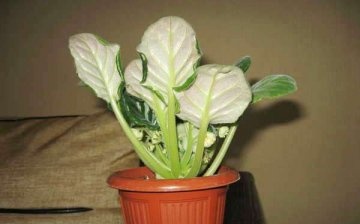
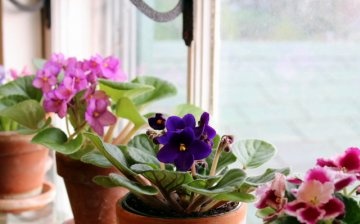
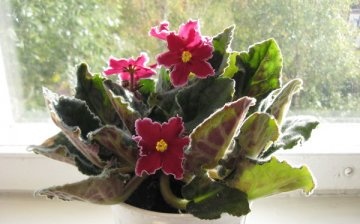
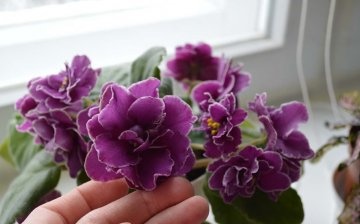






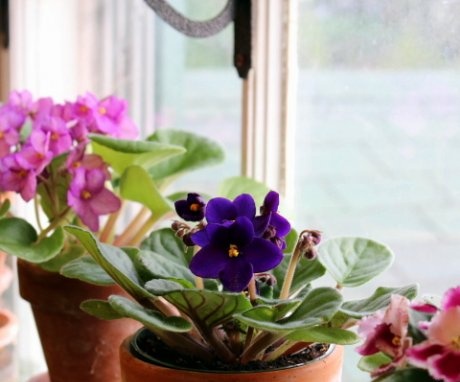
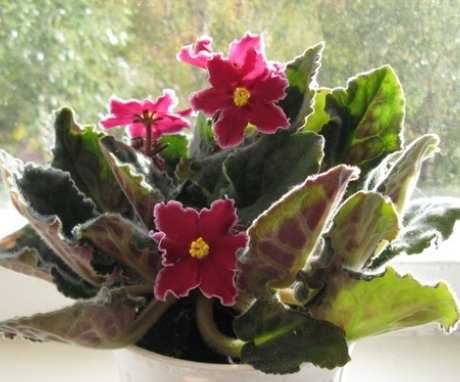
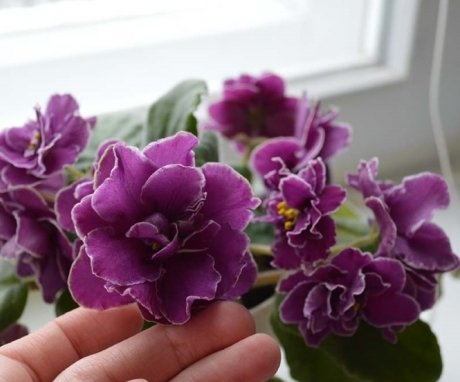
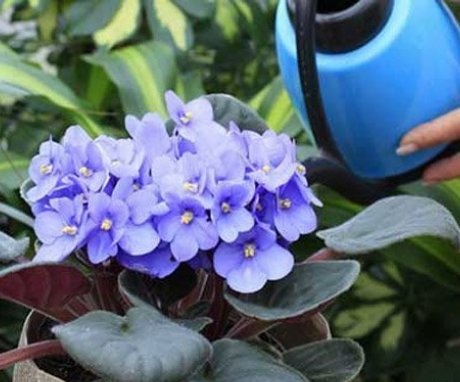
I have one violet just lifted up its leaves. Since the lighting on the window is very good, I suppose that in my case it is depletion of the soil in the pot, I will try to fix everything in the near future.
So I read carefully the reasons for raising the leaves - perhaps, I also have a reason for the impoverishment of the soil, but it always seemed to me that they then descended by themselves. We must watch more!
And my violet leaves grow horizontally, each flower takes up a lot of space and, on the contrary, I would like the leaves to grow more upward and there was more space on the window for other specimens.
Who writes about sufficient lighting, look, maybe it's still excessive? Does the sun's rays hit it? If yes, then change the place or try to somehow block the flower from direct rays. Violet loves light, but not rays. I just start raising the leaves closer to summer, when the sun begins to shine brightly.